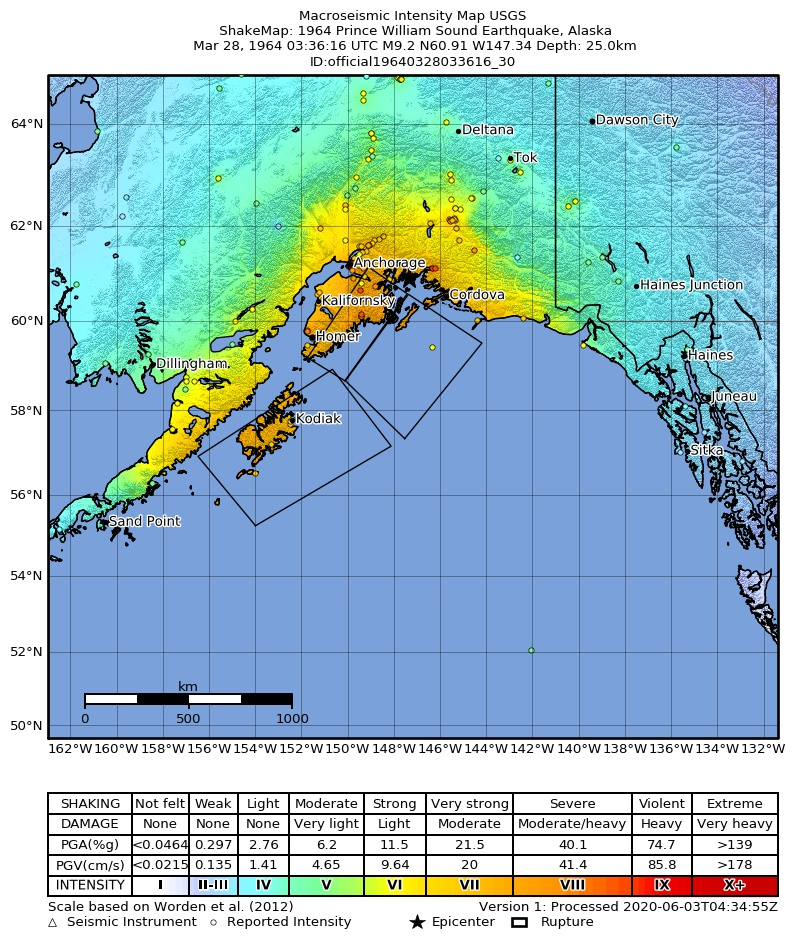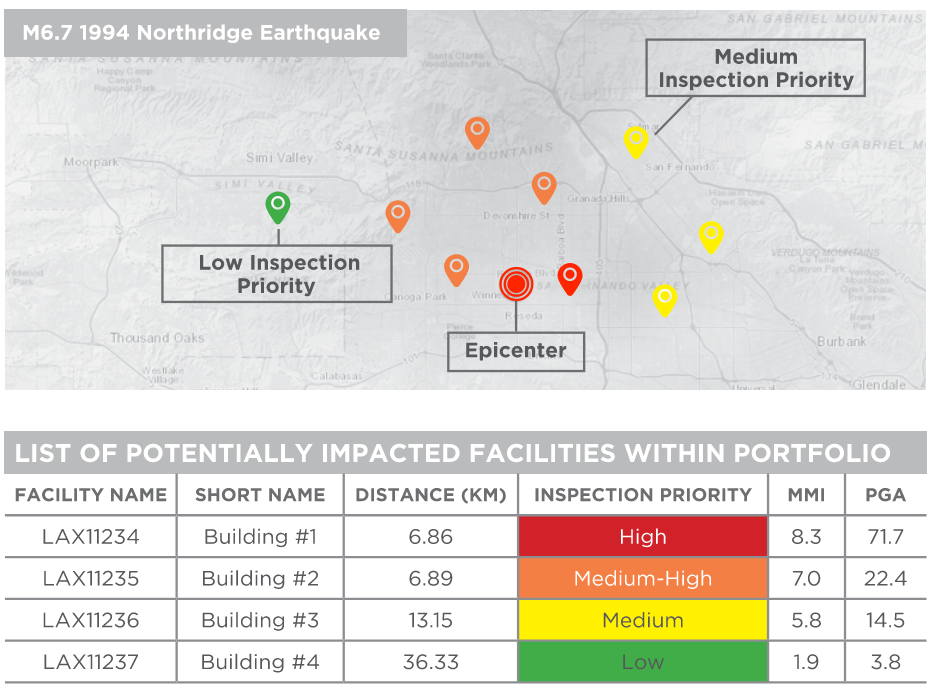[authors: Aaron Malatesta, Jeffrey Dyer, Zamir Orozco Jurado, and Tim Martin]
Introduction: Understanding ShakeCast and Its Role in Earthquake Risk Management
For building owners managing thousands of properties the risk posed by earthquakes is a significant concern. Rapid response is crucial to ensure the safety of occupants and the integrity of buildings. In the aftermath of an earthquake, property stakeholders need to quickly determine three specific facts for their portfolio of buildings:
- Which buildings need to be evacuated to protect lives?
- Which buildings require immediate inspection to assess structural damage?
- When is it safe for occupants to re-enter the evacuated buildings?
Because rapid response is essential, we leverage the United States Geological Survey (USGS) ShakeCast system to provide property stakeholders with a service for automated real-time earthquake inspection priority reports, enabling them to make swift and informed decisions in the aftermath of a seismic event.
ShakeCast is a post-earthquake situational awareness software application. It was developed and is managed by the National Earthquake Information Center (NEIC), which is responsible for monitoring and reporting on global seismic activity. The NEIC is managed by the United States Geological Survey and ensures that ShakeCast receives real-time earthquake data from seismic networks worldwide. Notable institutions, including state DOTs, utilities, large corporations, and emergency management agencies, use ShakeCast to enhance their earthquake response and risk management strategies.
In order to implement ShakeCast, users must develop a building portfolio database with pre-defined building-specific damage thresholds based on location and characteristics of each building. ShakeCast utilizes ShakeMap, a USGS product that provides near-real-time maps of shaking intensity following earthquakes and compares these intensity measures to building damage thresholds for each specific building to determine inspection priorities. ShakeCast should be hosted on a web server, ensuring it can continuously process ShakeMap data in real-time.
Implementation of ShakeCast provides property stakeholders automated e-mail notifications and detailed inspection priority reports which enhance property stakeholders’ situational awareness, allowing them to optimize resource allocation in the aftermath of an earthquake
Measuring Ground Shaking Intensity at Each Building in Real-Time
In general, ground shaking does not decrease uniformly in areas located further from the epicenter of an earthquake; rather, it varies nonlinearly. Many factors, such as local soil conditions, the depth of the earthquake, fault characteristics, and the geological characteristics of the region can influence shaking intensity. ShakeCast provides real-time data on earthquake shaking by utilizing USGS’s real-time earthquake monitoring. When an earthquake occurs, ShakeCast retrieves data from ShakeMap, which generates detailed maps of ground shaking intensity based on data recorded from regional and global seismic networks. These maps are analyzed to determine the shaking intensity at each specific building within a portfolio.

Figure 1 – USGS ShakeMap (Source: USGS).
ShakeCast should be hosted on a web server, ensuring it can continuously process ShakeMap data in real-time. Our firm has successfully integrated ShakeCast into our systems utilizing container technology, which has revolutionized software development by enhancing portability, scalability, and consistency. We have chosen Microsoft Azure as our primary cloud provider due to its comprehensive ecosystem for managing and deploying containerized applications. Specifically, we utilize Azure Container Instances (ACI) for ShakeCast. This cloud-based approach allows us to leverage Azure’s robust infrastructure, ensuring high availability, rapid deployment, and security for our clients. By hosting ShakeCast on Azure, we can efficiently manage and process real-time earthquake data, providing our clients with immediate insights and actionable information. Each client is supported by independent containers deployed with ShakeCast and integrated with our internal communication systems.
Pre-Defined Building Damage Thresholds
ShakeCast performs rapid damage predictions and sets inspection priorities by comparing shaking intensity against predefined building damage thresholds. ShakeCast relies on fragility curves from HAZUS methodologies to establish damage thresholds for individual buildings. HAZUS stands for Hazards U.S. It's a standardized methodology and software developed by FEMA to estimate potential losses from natural disasters like earthquakes, floods, hurricanes, and tsunamis. These fragility curves provide a statistical relationship between ground shaking intensity and the probability of reaching or exceeding various levels of structural damage. Building damage thresholds for each specific building are based on fragility curves assigned to various building classes, categorized based on their construction type, age, height, and use.

Figure 2 – Structural-damage fragility curve (Source: FEMA, 2014).
Building damage thresholds are evaluated against real-time earthquake information to predict damage and determine the inspection priority levels included in inspection priority reports. The accuracy of building damage thresholds depends on the amount and quality of information provided. More detailed data results in more refined and accurate models, while less information leads to simpler, less precise estimates. Even with less detailed data, the models can still provide valuable insights that may be sufficient for the needs of property stakeholders.
Automated Inspection Priority Reports
ShakeCast sends automated email notifications to emergency managers and responders that include inspection priority reports as well as details of the earthquake event that occurred. Inspection priority reports generated by ShakeCast provide a prioritized list of buildings that require inspection after an earthquake. The inspection priority levels in ShakeCast are designed to categorize buildings based on the severity of damage they may have sustained during an earthquake. These levels range from Green (minimal to no damage) to Red (severe damage). Green buildings are considered safe with little to no structural issues, while Red buildings require immediate inspection due to significant structural damage. Yellow and Orange levels indicate minor and moderate damage, respectively, necessitating timely but less urgent inspections.
This information is crucial for coordinating response protocols, such as evacuations and emergency repairs, streamlining operations, and improving overall response effectiveness. By identifying which buildings are safe to reoccupy and which require further inspection, ShakeCast helps prevent unnecessary closures and disruptions, protecting occupant safety and maintaining operational stability, thereby reducing the financial impact of earthquake events.

Figure 3 – Automated inspection priority report.
To ensure effective use of ShakeCast, we conduct comprehensive training sessions for our clients. These sessions cover the basics of earthquake monitoring and the specific functionalities of ShakeCast. We provide training to familiarize our clients with the system’s interface, alert mechanisms, and reporting tools. We can also run earthquake scenarios that allow them to conduct earthquake drills to keep their staff prepared for real-world scenarios.
Overcoming Implementation Challenges and Our Solutions
As the first company to implement ShakeCast using Microsoft Azure, we encountered several unique challenges. One of the primary hurdles was the integration of ShakeCast with Azure’s cloud infrastructure. This process required close collaboration with the team from the National Earthquake Information Center (NEIC) to troubleshoot and resolve various unknown system integration issues. These challenges ranged from data synchronization problems to ensuring the seamless operation of ShakeCast within the Azure environment.
Additionally, our company had to address complex security requirements to protect sensitive data and maintain compliance with industry standards. Ensuring that ShakeCast’s deployment on Azure met our stringent security protocols involved extensive testing and validation. This included configuring secure data transmission, implementing robust access controls, and conducting regular security audits to identify and mitigate potential vulnerabilities.
To overcome these challenges, we adopted a systematic and collaborative approach. Working closely with NEIC, we established a dedicated task force to address integration issues. This team conducted thorough testing and iterative troubleshooting, documenting each step to create a comprehensive guide for future implementations. Our collaborative efforts with NEIC were instrumental in resolving technical challenges and ensuring the smooth operation of ShakeCast on Azure.
In addressing our security requirements, we developed a set of best practices that included:
- Enhanced Security Protocols: Implementing advanced encryption methods for data transmission and storage, ensuring that all data handled by ShakeCast remained secure.
- Access Control Management: Establishing strict access controls and user authentication processes to prevent unauthorized access to sensitive information.
- Regular Security Audits: Conducting periodic security audits and vulnerability assessments to identify and address potential security risks proactively.
These solutions not only ensured the successful implementation of ShakeCast but also enhanced our overall security posture. By documenting our processes and lessons learned, we created a valuable resource for other organizations looking to implement ShakeCast with Azure, contributing to the broader community’s knowledge and best practices.
Future Applications of ShakeCast in Risk Management
The integration of ShakeCast into J.S. Held’s operations has significantly enhanced our ability to manage earthquake risks and respond effectively to seismic events. By leveraging the robust infrastructure of Microsoft Azure, we have ensured that ShakeCast operates with high availability, scalability, and security. Looking forward, we see opportunities to expand our use of ShakeCast to support risk management, parametric insurance services, and post-disaster claims estimation. These opportunities will further solidify our position as a leader in providing comprehensive risk management solutions and support to the insurance industry. By exploring new integrations, we aim to deliver unparalleled service to our clients.
Acknowledgments
We would like to thank our colleagues Aaron Malatesta, MS, PE, Jeffrey S. Dyer, SE, Zamir Orozco Jurado, and Tim Martin for providing insights and expertise that greatly assisted this research.